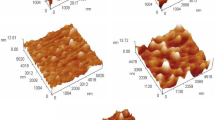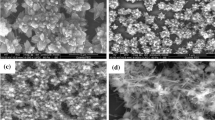Abstract
Recently, single-layer black phosphorous (phosphorene) has engrossed significant attention because of its considerable electronic properties. The remarkable properties of phosphorene, including high charge carrier mobility and semiconducting behavior, opened a view of its applications in nanoelectronics, nanosensing and 2D-material engineering. We investigate the effects of some gas molecules such as CO, CO2, O2, NH and NH3 on the zigzag phosphorene nanotube (ZPNT) behavior. First, we present the gas sensing properties of ZPNT doped with Boron and Nitrogen atoms, and then, we propose a new ZPNT structure to modify its gas sensing applications. In addition, the current–voltage (I–V) characteristics of the proposed structures are calculated via the non-equilibrium Green’s function formula. Based on I–V data, we determine the sensitivity of the ZPNT structures in presence of different gases molecules. According to the calculated results, the B-ZPNT, B-ZPNT proposed and N-ZPNT proposed are sensitive to CO2, CO and NH gas molecules, respectively.








Similar content being viewed by others
References
A.K. Geim, K.S. Novoselov, The rise of graphene. Nat. Mater. 6, 183–191 (2007)
A.K. Geim, Graphene: status and prospects. Science 324, 1530–1534 (2009)
A. Kara, A review on silicone: new candidate for electronics. Surf. Sci. Rep. 67, 1–18 (2012)
S. Cahangirov, M. Topsakal, E. Akturk, H. Sahin, S. Ciraci, Two-and one-dimensional honeycomb structures of silicon and germanium. Phys. Rev. Lett. 102, 236804 (2009)
Z. Ni, Q. Liu, K. Tang, J. Zheng, J. Zhou, R. Qin, Z. Gao, D. Yu, J. Lu, Tunable bandgap in silicene and germanene. Nano Lett. 12, 113 (2012)
F. Zhu, W.J. Chen, Y. Xu, C.L. Gao, D.D. Guan, C. Liu, D. Qian, S.C. Zhang, J.J. Jia, Epitaxial growth of two-dimensional stanene. Nat. Mater. 14, 1020–1025 (2015)
K.S. Novoselov, D. Jiang, F. Schedin, T.J. Booth, V.V. Khotkevich, S.V. Morozov, A.K. Geim, Two dimensional atomic crystals. Proc. Natl. Acad. Sci. 102, 10451 (2005)
H. Liu, Y, Liu, and D. Zhua, Chemical doping of graphene, J. Mat. Chem. 21, 3335–3345 (2011).
I. Zanella, S. Guerini, S.B. Fagan, J.M. Filho, A.G.S. Filho, Chemical doping-induced gap opening and spin polarization in graphene. Phys. Rev. B 77, 73404 (2008)
M.Y. Han, B. Ozyilmaz, Y. Zhang, P. Kim, Energy band-gap engineering of graphene nanoribbons. Phys. Rev. Lett. 98, 206805 (2007)
Y.W. Son, M.L. Cohen, S.G. Louie, Energy gaps in graphene nanoribbons. Phys. Rev. Lett. 97, 216803 (2006)
M.Z. Rahman, C.W. Kwong, K. Davey, S.Z. Qiao, 2D phosphorene as a water splitting photocatalyst: fundamentals to applications. Energy Environ. Sci. 9, 709–728 (2016)
L. Kou, C. Chen, S.C. Smith, Phosphorene fabrication, properties, and applications. J. Phys. Chem. Lett. 6, 2794–2805 (2015)
L. Li, Y. Yu, G.J. Ye, Q. Ge, X. Ou, H. Wu, D. Feng, X.H. Chen, Y. Zhang, Black phosphorus field-effect transistors. Nat. Nanotechnol. 9, 372–377 (2014)
N. Gergel-Hackett, A. A. Hill, A. C. Hacker, A. C. Richter, The integration of molecular electronic devices with traditional CMOS technologies, in 2008 8th IEEE Conference on Nanotechnology, IEEE-NANO 522–525 (2008), https://doi.org/10.1109/NANO.2008.156.
H. Du, X. Lin, Z. Xu, D. Chu, Recent developments in black phosphorus transistors. J. Mater. Chem. C 3, 8760–8775 (2015)
A. Castellanos-Gomez, Black phosphorus: narrow gap, wide applications. J. Phys. Chem. Lett. 6, 4280–4291 (2015)
A. Castellanos-Gomez, L. Vicarelli, E. Prada, J.O. Island, K.L. Narasimha-Acharya, S.I. Blanter, D.J. Groenendijk, M. Buscema, G.A. Steele, J.V. Alvarez, Isolation and characterization of few-layer black phosphorus. 2D Mater. 1, 025001 (2014)
S.P. Koenig, R.A. Doganov, H. Schmidt, A.H. Castro Neto, B. Ozyilmaz, Electric field effect in ultrathin black phosphorus. Appl. Phys. Lett. 104, 103106 (2014)
W. Zhu, M.N. Yogeesh, S. Yang, S.H. Aldave, J. Kim, S.S. Sonde, L. Tao, N. Lu, D. Akinwande, Flexible black phosphorus ambipolar transistors, circuits and AM demodulator. Nano Lett. 15, 1883–1890 (2015)
V. Sorkin, H. Pan, H. Shi, S.Y. Quek, Y.W. Zhang, Nanoscale transition metal dichalcogenides: structures, properties, and applications. Crit. Rev. Solid State Mater. Sci. 39, 319–367 (2014)
H. Liu et al., Phosphorene: an unexplored 2D semiconductor with a high hole mobility. ACS Nano 8, 4033–4041 (2014)
W. Lu, H. Nan, J. Hong, Y. Chen, C. Zhu, Z. Liang, X. Ma, Z. Ni, C. Jin, Z. Zhang, Plasma-assisted fabrication of monolayer phosphorene and its Raman characterization. Nano Res. 7, 853–859 (2014)
A.H. Woomer, T.W. Farnsworth, J. Hu, R.A. Wells, C.L. Donley, S.C. Warren, Phosphorene: synthesis, scale-up, and quantitative optical spectroscopy. ACS Nano 9, 8869–8884 (2015)
G. Seifert, E. Hernandez, Theoretical prediction of phosphorus nanotubes. Chem. Phys. Lett. 318, 355–360 (2000)
S. Yu, H. Zhu, K. Eshun, A. Arab, A. Badwan, Q. Li, A computational study of the electronic properties of one-dimensional armchair phosphorene nanotubes. J. Appl. Phys. 118, 164306 (2015)
J.W.G. Wilder, L.C. Venema, A.G. Rinzler, R.E. Smalley, C. Dekker, Electronic structure of atomically resolved carbon nanotubes. Nature 391, 59–62 (1998)
H. Guo, N. Hu, J. Dai, X. Wu, X.C. Zeng, Phosphorene nanoribbons, phosphorus nanotubes, and van der Waals multilayers. J. Phys. Chem. C 118, 14051–14059 (2014)
V. Sorkin, Y. Cai, Z. Ong, G. Zhang, Y.W. Zhang, Recent advances in the study of phosphorene and its nanostructures. Crit. Rev. Solid State Mater. Sci. (2016). https://doi.org/10.1080/10408436.2016.1182469
E. Montes, U. Schwingenschlogl, Superior selectivity and sensitivity of blue phosphorus nanotubes in gas sensing applications. J. Mater. Chem. C 5, 5365–5371 (2017). https://doi.org/10.1039/c6tc05094h
Author information
Authors and Affiliations
Corresponding author
Additional information
Publisher's Note
Springer Nature remains neutral with regard to jurisdictional claims in published maps and institutional affiliations.
Rights and permissions
About this article
Cite this article
Bahmani Kazerooni, H., Ghayour, R. & Pesaran, F. Analysis and application of zigzag phosphorene nanotube as gas nanosensor. Appl. Phys. A 127, 420 (2021). https://doi.org/10.1007/s00339-021-04513-w
Received:
Accepted:
Published:
DOI: https://doi.org/10.1007/s00339-021-04513-w




